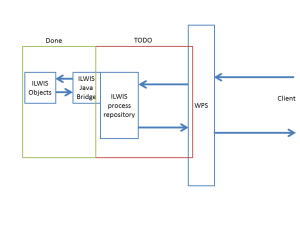The goal of this Google Summer of Code project was to create a bridge between Ilwis-objects and the 52°North WPS by adding Ilwis-objects as a processing backend. With this WPS extension, users can carry out ILWIS commands on a remote server via the WPS service interface.
more >
WPS-Ilwis Bridge – Midterm Post
The goal of this Google Summer of Code project is to extend the 52°North WPS‘s functionality by adding Ilwis-Objects as a processing backend. The 52°North currently supports several different backends, such as R or GRASS. The introductory blog post can be found here.
The current status of the project can be seen in the following diagram.
Statistics for OGC Web services – Midterm report
Introduction
The project goal is to collect statistics about how the clients use the SOS and WPS deployments. The data is collected in an Elasticsearch database. If you would like to read more about this proposition, please read the project’s first blog post.
Status
After 4 weeks of development, a new statistics module has been integrated into the SOS 4.x project. The following features are currently available:
- Core, Enhanced, Transactional and Result Handling OGC SOS 2.0 requests are listened for and their parameters are persisted into the Elasticsearch.
- The ExceptionEvents are also caught and loaded into Elasticsearch.
- The client’s source IP address is stored in the Elasticsearch database as a geo-location address. The transformation is provided by the Maxmind’s GeoLite2 databases. The geo-location information can be visualized on a Kibana tile-map.
- All the persisted information could be visualized and queried in Kibana.
Statistics for OGC Web services
Maintainers of 52°North web services currently have no information about the usage of their web services. User tracking is an important tool to understand user interest, requirements, and to ensure web services are working properly. But for OGC services, mere web usage statistics are not sufficient. They lack the thematic information. An administrator of a 52°North SOS does not know what the “most common” requested procedures are and when people are requesting data for which area and time frame. Are users mostly interested in the last week, or do they request historical data as well? Which sensor stations rarely get any queries?
- « Previous Page
- 1
- 2
- 3
- 4
- 5
- …
- 9
- Next Page »
